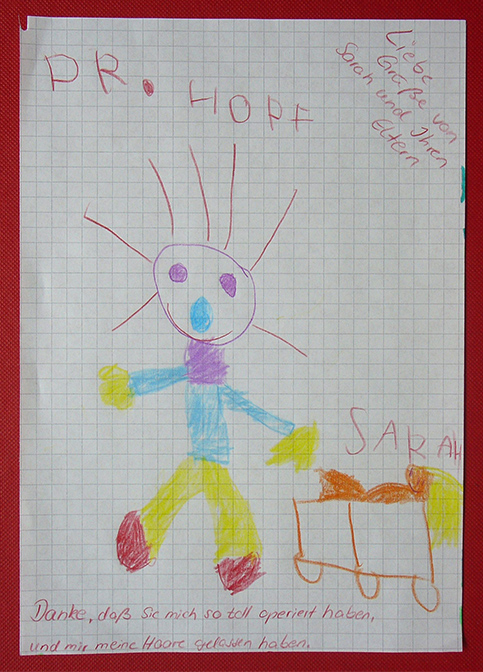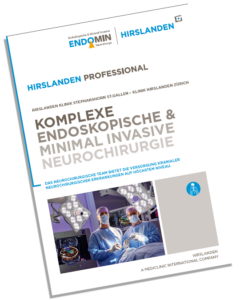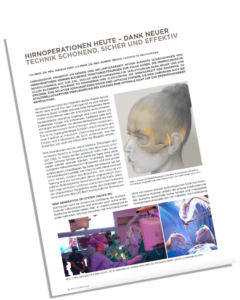SPINAL DISEASES
THE SPINE ISN'T DESIGNED TO LAST LONGER THAN 35 YEARS…
The most common spinal diseases arise due to signs of wear. Also known as degenerative diseases, they can be detected in practically every human being over the age of 35. Fortunately, many changes are not very detrimental or can be managed well with conservative treatment. However, where the symptoms are therapy-resistant and/or there are signs of paralysis, surgical treatment is usually unavoidable. The lowest possible surgical load on the spine is also crucial, in order to accelerate postoperative recovery. Tumours of the spine can occur in the bone, nerve canal or spinal cord. In addition to irritations such as pain and discomfort, spinal diseases can also lead to neurological failures in the arms and legs, and even paraplegia. This is why rapid action is often required.
At our centre, we treat all types of spinal diseases. Through our close interdisciplinary cooperation with neuroradiologists, neurologists and radiologists in the ENDOMIN NETWORK, we can provide treatment based on the latest medical findings using all available methods.
In the following sections you will find information about the most important forms of spinal diseases, their symptoms, diagnosis and treatment options as well as explanations about special techniques and treatment strategies used at our centre.
HERNIATED DISCS
Wear and tear of the intervertebral discs – the cartilaginous shock absorbers between the vertebral bodies – begins from the age of 20. This can be intensified by repeated one-sided and unnatural strain on the spine, as well as incorrect posture. In the majority of people with healthy spines, a nuclear spin tomogram (MRI) will also show signs of wear on the intervertebral discs, but usually without indications of disease. However, around 5% of the general population will suffer from a herniated disc in the course of their lives. Due to
cracking in the outer fibrous ring, soft intervertebral disc material emerges towards the spinal canal or the nerve roots and this can exert pressure on nerve roots or the spinal cord.
The symptoms caused by a herniated disc will differ depending on the size and level of the prolapse (cervical, thoracic or lumbar spine).
Initially, there is frequently unspecific neck pain, radiating into an arm with compression of a nerve root, near the supply area of the affected root. Sensory disturbances and a loss of strength can also occur. When the spinal cord is compressed in the spinal canal, all motor and sensory functions below the affected height can be impaired, and this can go as far as complete paraplegia.
Herniated discs of the thoracic spine are very rare compared to those of the cervical and lumbar spine. The symptoms are often unspecific chest and abdominal pain. Weakness in one or both legs is also possible; in extreme cases, paraplegia can occur.
Although many patients also complain of back pain, the main symptom of a lumbar prolapsed disc is a severe pain radiating into the leg. Sensory disturbances (numbness, pins and needles, tingling) or a reduction in muscle strength can also occur. The spread of the pain, the sensory disturbances and the muscle weakness depends on the affected nerve root; these symptoms are often typical and can be accurately pinpointed even without imaging.
Very large herniations of the discs can cause a disturbance of the bladder or rectal function. This is always a neurosurgical emergency that requires urgent surgery.
Magnetic resonance imaging (MRI) is the examination of choice for showing the soft tissues (intervertebral discs, ligaments, joint capsules, spinal cord and nerve roots). Bony structures are better represented in a CT. The dynamic properties of the spine can be assessed using functional X-ray imaging.
Irrespective of the location, the treatment of disc disease is primarily conservative. The vast majority of intervertebral disc complaints can be
successfully treated within 6-12 weeks by conservative treatment in the acute phase, pain medication followed by physiotherapy and, if necessary, X-ray-controlled infiltrations. A relative surgical indication exists for severe pain that does not respond adequately to therapy, and where there are minor signs of paralysis.
On the other hand, an absolute neurosurgical emergency exists in the case of severe paralysis and/or disorders of the bladder or rectal function. In case of acute bladder paralysis, the operation must be performed within hours.
Cervical spine
As a rule, the intervertebral disc is removed via frontal access, and either a placeholder (a cage made of titanium or plastic) or an intervertebral disc prosthesis will be inserted. The release of the trapped nerves usually leads to immediate freedom from symptoms. The risk of nerve or spinal cord injury is minimal (well below 1%). If a small herniated disc is located more laterally, it can also be removed from behind. At our centre, this procedure, known as a Frykholm operation, is performed minimally invasively, with minimal muscular injury. With this technique, the cervical spine is reached using the technique of dilatation, via a skin incision just 10 mm long. The herniated disc is then removed in an endoscopic-assisted procedure, through a narrow working channel. Due to the very small skin incision and the minimal strain on the muscles, the postoperative pain is significantly reduced.
Thoracic spine
Due to the anatomical conditions in the region of the thoracic spine (expanded spinal cord and relatively narrow spinal canal), operating in this region is complex, compared to other spinal column operations. At our centre, these procedures are carried out under continuous neuromonitoring.
Lumbar spine
At our centre, all operations on the lumbar spine are carried out endoscopically or endoscopically-assisted. These techniques allow us to access the pathologically altered structures as gently as possible while protecting the elements supporting the spine (muscles, ligaments and intervertebral joints). Due to the very small skin incision and the minimal strain on the muscles, there is hardly any measurable blood loss. There is significantly less postoperative pain, the patient is able to stand up on the day of the operation and leave the clinic after a short time.
Where there is extensive intervertebral disc degeneration, intervertebral disc prostheses can sometimes be used. If there is also symptomatic segmental instability (slipped vertebrae), in certain circumstances a vertebral body stiffening (spondylodesis) may be necessary. At our centre, these procedures
can be carried out under navigation control and using intraoperative CT examinations.
Through the use of endoscopic and endoscopic-assisted techniques, the surgical access to the spine can be positioned gently and the muscles protected. This promises minimal surgical injury and rapid postoperative recovery.
SPINAL STENOSIS
As part of the natural ageing process of the spine, which can be intensified by incorrect posture or unnatural or repetitive strains, various elements of the spine can degenerate. The intervertebral discs, joints and ligaments show signs of wear which can ultimately lead to a narrowing of the vertebral canal and/or the exit points of the nerve roots. Occasionally, this constriction will be complicated by spondylolisthesis.
Typically it is elderly patients (> 60 years) and more women than men who are affected.
The classic symptom of spinal stenosis is the shortened walking distance. After walking or standing for a short time, there is increasing pain in the legs. A feeling of heaviness and unpleasant sensations (pins and needles, burning) in the legs are also possible. Back pain is also common, but usually not obtrusive. Compared to “shop window disease”, which is caused by a circulatory disorder of the legs, with spinal stenosis, cycling is often possible and symptoms can be improved by bending forward.
Neurological deficits such as motor paralysis or sensory disturbances are mostly mild and are often not even noticed by the patient.
Magnetic resonance imaging (MRI) is the examination of choice for showing the soft tissues (intervertebral discs, ligaments, joint capsules, spinal cord and nerve roots). Bony structures are better represented in a CT. The dynamic properties of the spine can be assessed using functional X-ray imaging. It is also necessary to rule out the presence of a circulatory disorder of the legs, which can cause similar symptoms.
The course of the disease is usually gradual. In the initial phase, conservative treatment can be beneficial. However, physiotherapy, back training, painkillers and finally infiltrations (trigger points, intervertebral joints) usually have only a suspensive effect. This is because the underlying pathomechanism is a
mechanical irritation of the nerves and the conservative treatment methods cannot produce a causative solution to the disease.
The aim of each operation is to widen the narrowed segment and/or nerve windows. Various techniques are used for this purpose (interspinous decompression, recessive decompression, unilateral fenestration with undercutting to the opposite side, bilateral fenestration). The optimal procedure will depend on the specific characteristics of the disease and will be determined individually. All operations at our centre are carried out microsurgically or endoscopically-assisted, and the aim is to protect all the supporting and stabilising elements of the spine.
At our centre, we often use intraoperative myelography and computed tomography. After the access has been created, the spinal canal will be punctured before decompression and an iodine contrast agent will be injected. A lateral radioscopy and CT will then accurately show the narrowing. After surgical decompression, the CT will be repeated; the wound will only be closed when the spinal canal is completely decompressed.
BRAIN AND SKULL BASE TUMOURS
Spinal tumours include all benign and malignant tumours of the spine. They can affect the bone, originate from the nerve root, lie inside or outside the spinal canal or arise directly in the spinal cord. Tumours within the spinal cord membrane are known as intradural tumours. They include tumours of the spinal cord, intramedullary tumours (such as astrocytoma or ependymoma), and extramedullary tumours, which displace the spinal cord (they include neurinomas or meningiomas of the spinal cord membrane). If untreated, spinal tumours can damage the spinal cord due to their growth and thus ultimately lead to paraplegia.
The most common symptoms of a spinal tumour are localised tension or radiating back pain, initially while resting at night. Later, other neurological disturbances will occur, such as numbness, reduced strength, bladder and rectal disorders and disorders of sexual function. The extent of the symptoms depends on the size and location of the tumour. The patient often does not notice the symptoms until late, since the tumours often grow very slowly and initially cannot be felt in the healthy fibres. Sometimes, the patient’s relatives might notice some uncertainty in walking, which is typically more pronounced in the dark. This ataxic, clumsy movement of the extremities, together with pain, are usually the first signs of the disease.
The diagnosis consists of a clinical-neurological examination followed by imaging procedures. In order to assess the compression of the spinal cord or nerve fibres, an MRI will be taken of the entire spine. To represent the bony vertebral structures, a computed tomography (CT) is carried out. The stability of the spinal column is best assessed using functional X-ray images.
With most spinal tumours, surgery is offered in order to ensure the type diagnosis of the tumour and to relieve pressure on the spinal cord. If there is a tumour-induced instability of the spine, a fusion of the affected segments is often necessary. Benign tumours can be cured by complete removal. In the case of malignant tumours, such as metastases or lymphomas, chemotherapy and/or irradiation are usually still necessary after the operation. For patients with a tumour-related cross-section, intensive physiotherapy is carried out in our clinic after the acute treatment. This is followed by neurological rehabilitation in consultation with our oncology and radiotherapy specialists, in order to optimally coordinate the aftercare treatment if necessary.
The aim of the operation is to achieve maximum radicality via the safest route. The risk of postoperative neurological deficits can be minimised by using state-of-the-art technology. It is important to preserve the neurological function in order to avoid paralysis, sensory disturbances or other disorders caused by the operation. The decisive factor here is the use of electrophysiological monitoring, with constant monitoring of the conduction pathways of the spinal cord and the outgoing nerve roots.
However, the prevention of access-related injuries to the spinal column and its ligaments also plays an important role in preventing subsequent instability. Therefore, at our centre, tumours are reached via a minimally invasive access, whereby the muscles are mobilised and traumatised as little as possible. This affects the dynamics and statics of the spine as little as possible.
The use of minimally invasive methods with protection of these structures leads to a painless recovery and faster rehabilitation into private and professional life.
Contact
+41 44 387 28 29
Treatment Request
Happy Patients


Questions and Answers
about endoscopic neurosurgery



